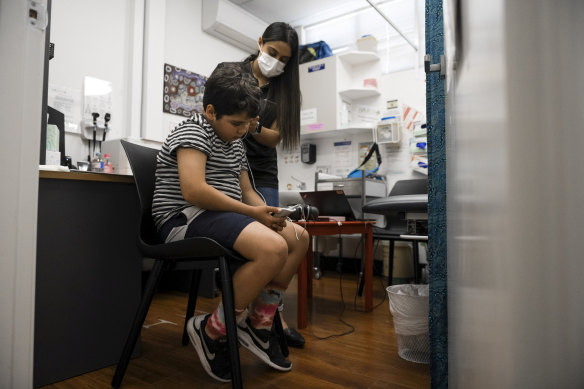This was published 4 years ago
Why one in four Indigenous kids is suffering from hearing loss
A national hearing assessment program has identified almost 500 Indigenous children with undiagnosed hearing loss in its first year of operation.
Aboriginal and Torres Strait Islander children suffer the highest reported rates of otitis media (middle ear infection) in the world, with studies showing they are five times more likely to be diagnosed than non-Indigenous children. Left untreated, it can lead to permanent hearing loss and learning difficulties due to poor language development.

Audiologist Arveen Kaur tests the hearing of Jackson Wellington in Nowra.Credit: Rhett Wyman
A $30 million federally funded screening program led by Hearing Australia is working with Indigenous health organisations to identify such infections before they become permanent. Almost a quarter of the 2100 children assessed in 67 communities over the past year had undiagnosed hearing problems.
Loretta Longbottom knows the value of early intervention.
Her adult daughter had otitis media as a child and now has 25 per cent hearing loss in one ear.
Ms Longbottom, an Aboriginal health practitioner at the Waminda Women’s Health Centre in Nowra, directs local families to the screening program to help their children avoid the same fate.
“This is an opportunity I want our people to take seriously because at the end of the day, our children's hearing is affected and that does impact on their way of life,” she said.
Otitis media is caused when fluid builds up in the middle ear cavity and becomes infected. For most non-Indigenous children, it is readily treated without long-term effects.
An Indigenous child will typically endure middle ear infections for at least 32 months, compared with three months for a non-Indigenous child, from age two to 20 years, according to the Australian Medical Association.
Health experts say the condition is more likely to become chronic in Indigenous communities due to poverty, overcrowded housing and a mistrust of, or lack of access to, health services.
Hearing issues have become normalised in some communities, such as remote areas of the Northern Territory where a 2013 study found almost 90 per cent of Indigenous children under 3 had otitis media.

Kylie Christopher with her one-year-old daughter, Miamii, at Waminda Women's Health Centre in Nowra. Credit: Rhett Wyman
The screening program, aimed at children under 5, works with local Aboriginal community-controlled health centres to monitor children and refer them for further medical treatment or speech pathology services where necessary.
Senior audiologist Sarah Love says the ultimate goal is to train Aboriginal health workers to conduct the hearing assessments themselves.
“If we can get the message out there with families that hearing health and ear health is really important for children's lives and their performance at school, we expect that will make a huge difference to overall outcomes for Aboriginal children as they get older,” she said.